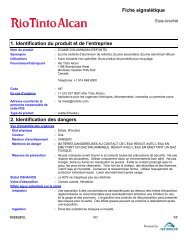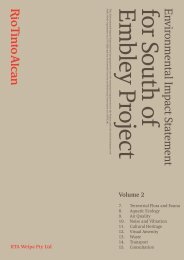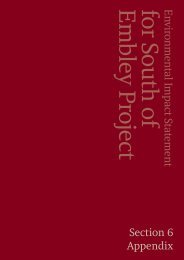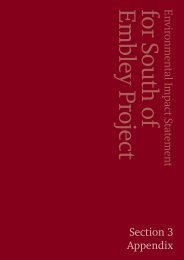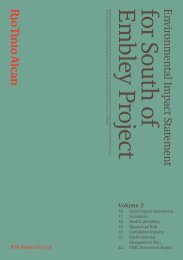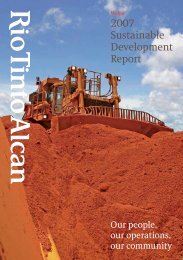Embley
Health and safety - Rio Tinto Alcan
Health and safety - Rio Tinto Alcan
Create successful ePaper yourself
Turn your PDF publications into a flip-book with our unique Google optimized e-Paper software.
Environmental Impact Statementfor South of<strong>Embley</strong> ProjectSection 18Health and Safety
Rio Tinto AlcanEnvironmental Impact StatementSouth of <strong>Embley</strong> Project18 HEALTH AND SAFETYThis section examines the health and safety implications associated with the Project during theconstruction and operational phases. The health and safety of Project personnel and the publicare assessed, and mitigation strategies outlined where appropriate.Community impacts for health and safety are addressed in respective sections of the EIS. Forexample, the potential for air emissions and impact on community health are addressed inSection 9. There are no sensitive receptors, such as kindergartens, schools, hospitals, agedcare facilities, residential areas, and commercial places close to the mining, processing or portareas (refer Figure 9-1). As such, there would be no planned discharges from the Projectwhich could impact on public health values in the short or long-term.Most activities proposed for the Project are similar to those currently carried out by the existingRTA operations north of the <strong>Embley</strong> River and therefore the health and safety risks remain thesame.18.1 Overview of the Existing Environment - Health and SafetyRTA considers the safety and health of employees and contractors as paramount and afundamental requirement for continued operation and growth. The success and performance ofRTA in these areas is judged by employees, contractors, regulators and the community andinfluence the ability of RTA to enhance and develop future resources.The RTA Health, Safety and Environment (HSE) Policy (refer Appendix 1A) clearlydemonstrates the commitment by RTA to health and safety.Performance is measured and reported publicly in the Weipa operation's annual SustainableDevelopment Report and is summarised in Table 18.1. Annual targets are set, with an aim ofimproving performance each year.Table 18-1Recent Health and Safety Performance Weipa OperationsLost Time Injury (LTI)frequency rateAll Injury (AI) frequencyrate2007 2008 2009 2010target0.47 0.30 0.10 0.090.85 0.46 0.60 0.54CommentsAn LTI occurs where the person injured at work cannotreturn to their normal duties on the next shift.AIs include LTIs and also any injury that requires medicaltreatment.(1) The "frequency rate" is the number of LTIs or AIs per 100 people working pe year.In 2008, RTA Weipa had its lowest AI frequency rate and LTI frequency rate on record. Theseresults occurred during a period of record production and construction work by contractors onthe East Weipa tailings storage facility.18.2 Guidelines, Policies and LegislationThe primary relevant health and safety legislation and regulatory requirements applicable to theProject are listed in Table 18-2.Table 18-2Primary Health and Safety LegislationRelevant Legislation Legislative Requirements ComplianceMining and Quarrying Safety and HealthAct 1999 (Qld) and Regulation 2001(amended 2008)Workplace Health and Safety Act 1995(Qld) (amended 2009) and Regulation2008Ensuring and promoting improved healthand safety performance in mining andquarrying.To prevent a person's death, injury orillness being caused by the workplace, oractivities.Risk Management SystemAccountabilities for safety and health.RTA Weipa HSE Management System.Include safety in design for constructionand operations.Section 18 Health and Safety Page 18-1
Rio Tinto AlcanEnvironmental Impact StatementSouth of <strong>Embley</strong> ProjectRelevant Legislation Legislative Requirements ComplianceBuilding Act 1975 (Qld) and Building Fireand Safety Regulation 2008Fire and Rescue Service Act 1990 (Qld)and Fire and Rescue Service Regulation2001Electrical Safety Act 2002 (Qld) andElectrical Safety Regulation 2002Dangerous Goods Safety Management Act2001 (Qld) and Regulation 2001Radiation Safety Act 1999 (Qld) andRegulation 1999Transport Operations (Road UseManagement) Act 1995 (Qld) andassociated regulations for dangerousgoods and other relevant aspects.Transport Operations (Marine Safety) Act1994 (Qld) and Regulation 2004Health Regulation 1996 (Qld)Workers' Compensation and RehabilitationAct 2003 (Qld) and Regulation 2003Petroleum and Gas (Production andSafety) Act 2004 (Qld) and Regulation2004Safe design and operation of all buildingsso as not to endanger persons, propertyor the environment.Establish effective relationships andimplementation of the Queensland Fireand Rescue Service and provide for theprevention of and response to fires andcertain other incidents endangeringpersons, property or the environment.Ensure safe utilisation, instalment and useof electricity so as not to endangerpersons, property or the environment.The Act establishes standards for thetransport and storage of hazardoussubstances and the systems to beadopted based on these substances.The Act establishes the requirements forhandling radioactive substances and themonitoring of persons exposed to thehazard.Provide for the effective and efficientmanagement of vehicle and road useassociated with all components andstages of the project.Provide for efficient management ofmarine safety and related marineoperational issues.Ensure dispensary activities (i.e. from anon-site occupational health clinic) do notendanger human health or theenvironment.Ensuring and promoting improved healthand safety performance.Ensuring safety in the provision andsupply of food.Includes requirements relating to gaswork licences and authorisations inrelation to gas devices.RTA Weipa HSE Management System.Compliance with the Building Code ofAustralia.Involve the Queensland Fire and RescueService in emergency planning.Safety in design and Safety ManagementSystem for construction and operationalphases.Comply with Australian Standards andimplement management systems asdefined for the storage and use ofsubstances.Undertake the requirements of theregulations as stated, including radiationmonitoring and screening as required.RTA Weipa HSE Management System forconstruction and operational phases.Rio Tinto Marine HSE ManagementSystem.RTA Weipa HSE Management System,including procedures for setup of first-aidfacilities, accountabilities of first-aidattendants, and approved contents offirst-aid kits.Risk Management System.Compliance safety audit required toensure compliance with Food StandardsCode and operators' food safety program.RTA Weipa HSE Management System,including procedures for pressure vesselsand pipelines.and Reliability) Act 2008 (Qld) To ensure safe and reliable water supply. Weipa Town Authority manages potablewater in the town of Weipa.RTA Weipa manages water on-sitethrough HSE Management System andpotable water monitoring program.Occupational Safety and Health (MaritimeIndustry) Act 1993 (Cwlth) andRegulation 1995To ensure the health, safety and welfareat work of maritime industry employees;and to protect persons at or nearworkplaces from risks to health and safetyarising out of the activities of maritimeindustry.Rio Tinto Marine operates under theirMarineSafe system.The process to achieve compliance with the above legislation is discussed in the followingsections.Section 18 Health and Safety Page 18-2
Rio Tinto AlcanEnvironmental Impact StatementSouth of <strong>Embley</strong> Project18.3 Project Health and Safety Management SystemRTA's existing integrated Health Safety and Environment (HSE) Management System (known asCLASSIC) is certified to ISO 14001 and OHSAS 18001 and is audited on an annual basis by anexternal auditor. An overview of the HSE Management System is provided in Appendix 18A.RTA would implement the existing CLASSIC HSE Management System as part of the Project.Similarly, Rio Tinto, as operators of the Lorim Point shiploader at the Port of Weipa, hasimplemented the Marine Safe system which implements the requirements of the AustralianMaritime Safety Authority and other relevant international statutory authorities, relevant classrules, regulations and ship management contracts. The ship managers of all Rio Tinto Marinefleet vessels are required to have certification to the International Safety Management Code(IMO 2002) and vessels must have on board a copy of the "Document of Compliance" endorsedfor annual verification. RTA would implement the Marine Safe system at the port proposed forthe Project.Both systems incorporate Occupational Health and Safety Standards that are currently in use atall Rio Tinto operations, which provide the basis for effective management of employee andcontractor health and safety.A Health Safety Environment and Communities Management Plan (RTA 2007) was developedspecifically for the Project area for resource assessment activities. This plan would continue tobe maintained, regularly reviewed and updated as activities change on-site until such time asthe Project area is incorporated into the existing HSE Management System. This would occurupon completion of construction.Monitoring of health and safety performance and internal and external audits of implementationof the system at the Project site would ensure effective implementation.Health and safety risks are identified via the HSE Risk Management System, described inSection 19. Section 19.2.2 defines the categories of risk. The high risks identified in thepreliminary Project hazard analysis and risk assessment are summarised in Table 19-6. Theprimary health and safety risks are discussed in further detail in the following sections.18.4 Personal Protective EquipmentPersonal Protective Equipment (PPE) refers to protective clothing, helmets, goggles, or othergarments designed to protect the wearer's body or clothing from injury by blunt impacts,electrical hazards, heat, chemicals, and infection, for job-related occupational safety and healthpurposes. The following mandatory PPE would be required in all external areas within theProject area:safety helmet;steel-cap boots;safety glasses; andhigh-visibility clothing.Other job-related PPE would be utilised where required and would be identified in Safe WorkProcedures.Section 18 Health and Safety Page 18-3
Rio Tinto AlcanEnvironmental Impact StatementSouth of <strong>Embley</strong> Project18.5 Health Impact Assessment and Mitigation MeasuresThe primary health risks identified through the preliminary Project hazard analysis and riskassessment and the associated control strategies that would be implemented through the HSEManagement System are discussed in the following sections. The control strategies addresslegislative and Australian Standard requirements where applicable.18.5.1 Air EmissionsDust is the principal atmospheric contaminant in the workplace. The crystalline silica (quartz)component of dust is of interest due to its potential as a carcinogen. RTA has undertakenrespirable crystalline silica monitoring in the workplace between 2005 and 2008 with results todate indicating the mean exposure to be
Rio Tinto AlcanEnvironmental Impact StatementSouth of <strong>Embley</strong> Projectwhere hearing protection is required a range of hearing protection devices that areapproved for site would be available;training would be provided in fitting, maintenance and the limitations of hearingprotectors;there would be documented procedures for inspection, assessment, and maintenanceof noise reduction devices and noisy equipment to ensure noise levels are minimised;employees would be given information, instruction and training regarding noisyenvironments, including the hazards, potential health effects and control mechanisms;a formal review of the practicality of engineering controls would be conducted annuallyin areas where a hearing conservation programme is required;each area where hearing protection is routinely worn (i.e. employees are exposed tonoise levels greater than 82dB(A) or 140dB(C)) would have a plan of action for thecontrol of noise, andall employees would attend audiometric testing as required.With the implementation of these control measures, the residual health risks associated withnoise and vibration are expected to remain moderate.The impact of noise emissions on the community are addressed in Section 10.18.5.3 Wildlife Hazards and Disease VectorsCertain wildlife, such as the estuarine crocodile, dingoes, venomous snakes and spiders, pose arisk to workers if they are bitten. The occupational health clinic and first-aid facilities would beequipped to respond to incidents of this type and provide appropriate treatment whererequired. Safe Work Procedures would be developed for activities (e.g. water sampling creeks)carried out near marine aggressor (crocodile, stingers, sharks) habitat. Personal protectiveequipment, such as boots, trousers and long sleeves would be required at all areas on theProject area, which would provide minimum protection from snake and spider bites. Gloveswould also be provided for use during appropriate tasks.A vector is an organism that does not cause the disease itself but transmits infection bytransferring pathogens from one host to another. Bedbugs, cockroaches, flies, lice, mosquitoes,rat fleas, rats and mice are all capable of transmitting disease. In Australia, diseases such asDengue Fever, Ross River Virus, and Barmah River Virus can be transmitted by mosquitoes. Inaddition, ships can spread disease to ports via infected vectors. The control of disease vectorssuch as insects and rodents is necessary for the maintenance of employee and communityhealth.The Weipa branch of the Australian Quarantine and Inspection Service (AQIS) undertakesmonitoring of tropical disease vectors such as mosquitoes regularly and has not reportedvectors of a quarantinable human disease to date. At the time of preparation of this EIS, therewas no evidence to suggest the recent outbreak of dengue fever in Queensland had extendedto the Weipa area (Queensland Health 2009).Control programs for disease vectors such as rats and mosquitoes and other insects would beundertaken in infrastructure areas on a regular basis by a licensed Pest Control Technician.The Project would implement CLASSIC 5.06 Travel Remote Site Health, which includes thefollowing controls for mosquito (and biting midges) safety:reduction or elimination of preferred breeding water sources such as stagnant water incontainers;staying indoors during mosquito activity hours;wearing clothing that reduces the amount of skin exposed (i.e. long trousers and shirtsleeves) between dusk and dawn, andapplying insect repellent.Section 18 Health and Safety Page 18-5
Rio Tinto AlcanEnvironmental Impact StatementSouth of <strong>Embley</strong> ProjectWater storages and other impoundments of water can be used by mosquitoes and bitingmidges for breeding. Water storages and other impoundments of water constructed on theProject site would be greater than 60cm deep and not conducive to mosquito breeding, inaccordance with the Guidelines to minimise mosquito and biting midge problems in newdevelopment areas (Queensland Health 2002).Overseas ships would be subject to AQIS requirements for vessels, including the requirement tomanage potential disease vectors.The Project is not expected to increase the number of pests during construction or as a result ofsite operations.18.5.4 Drinking Water SupplyThe Weipa Town Authority (WTA) is responsible for providing potable water services to thetown of Weipa, where employees and contractors would live throughout the operation of theProject. WTA collects water samples on a weekly basis for bacterial testing and a quarterly basisfor minerals, hardness and pH. Test results are provided on the WTA web page and areavailable for public viewing at the Town Office.Potable water would be provided at the Project construction camp, the proposed port andinfrastructure areas. The water would be sourced from dams and groundwater sources andtreated to ensure a potable standard. RTA would regularly monitor potable water quality toensure compliance with the Australian Drinking Water Guidelines (NHMRC 2004).The risk of unsafe drinking water is considered to remain low.RTA would not be a "water service provider" in the Project area for the purposes of the WaterSupply (Safety and Reliability) Act 2008, as the infrastructure would be for mining purposes andthe service would only be used by the owner's employees and visitors.18.5.5 Use of Recycled WaterDuring construction, it is anticipated that effluent from the sewage treatment plant would berecycled for use in landscaping areas. During operations, water from tailings storage facilitiesand infrastructure area sewage treatment plants would be recycled (refer to water managementsystem Figure 5-8 and Figure 5-9).In both instances, recycled water would be managed in accordance with the Water Supply(Safety and Reliability) Act 2008 and relevant environmental and health regulatory guidelines.This would include monitoring to ensure water quality meets the Water quality guidelines forrecycled water schemes (DNRW 2008). Details of operations of the sewage treatment plants,including proposed water quality monitoring and recycled water criteria are discussed inSection 13.3.7.Recycled water would not be used for irrigation of food crops or in other areas that may impactthe human food chain.18.5.6 Food HygieneAreas involved with the provision and supply of food, such as the construction camp, wouldoperate in accordance with current food and hygiene legislation. RTA would engage theservices of a contractor to supply food to the construction workforce. All catering contractorswould be required to undertake food handling training and hold relevant licences under theFood Act 2006.Under this Act, caterers are required to develop and implement food safety programs and,depending on the number of people catered for, the program may need to be accredited.Accredited programs are required to have a compliance safety audit completed by an accreditedauditor to ensure the business is complying with their program and the Food Standards Code(FSANZ 2000). This requirement is likely to be triggered during the construction phase of theProject.Section 18 Health and Safety Page 18-6
Rio Tinto AlcanEnvironmental Impact StatementSouth of <strong>Embley</strong> ProjectPerformance monitoring of all contractors would be undertaken in accordance with RTA'sSupplier and Contractor Management Standard.18.5.7 Other Biological HazardsInfectious diseases may also be transmitted via bodily fluids, such as medical staff exposedwhile treating a patient. All first-aid facilities would be equipped with gloves and otherprotective equipment in accordance with standard medical practice. Clinical waste would besegregated and disposed of at the Evans Landing Landfill (in accordance with the existingLicence).Personnel are also at risk of bacterial or infectious disease when working on or near sewagetreatment facilities. Safe operating procedures would be developed for this work, including theuse of appropriate PPE and hygiene practices (e.g. washing hands before consuming food).Legionella can be contracted via inhalation of water vapour containing the Legionella bacteria.Regular testing of at-risk water sources (e.g. beneficiation plant, hot-water storages etc) wouldbe carried out and the water treated where required.With the proposed control measures in place, the risks associated with other biological hazardsare considered to be moderate.18.5.8 Hazardous SubstancesFuels (predominantly diesel), detergents, lubricants and oils, solvents, degreasers, paints, resinsand domestic cleaning agents would form the majority of chemicals required at the Project site.The following controls would be implemented:All chemicals would be managed in accordance with the NOHSC:1015 National Standardfor the Storage and Handling of Workplace Dangerous Goods (NOHSC 2001), theNOHSC1005 National Model Regulation for the Control of Workplace HazardousSubstances (NOHSC 1994), and NOHSC1008 Approved Criteria for ClassifyingHazardous Substances (NOHSC 2004).In addition, chemicals would be managed in accordance with CLASSIC 2.06 HazardousSubstances Control, which requires a risk assessment to be completed, taking intoaccount information from the Material Safety Data Sheet (MSDS), prior to the substancebeing brought to site.A register of all approved chemicals would be maintained.All chemicals would be labelled and stored according to the requirements of therespective MSDS and relevant Australian Standards. Copies of MSDS's would be keptnear storage areas.PPE (e.g. gloves, face shields or respiratory-protection devices) and first-aid equipment(e.g. emergency showers and eye-wash stations), as identified in the MSDS and/or riskassessment would be maintained and available for use.Training would be provided to employees and contractors through the site inductionand specific chemical awareness programs for relevant workers.With the implementation of proposed controls, the residual health risk presented by hazardoussubstances is expected to be moderate.18.5.9 RadiationExposure to ultra-violet radiation and heat stress from the sun is a significant risk in the tropicalenvironment. All employees and contractors would be required to wear long-sleeve shirts,trousers and hats to help reduce sun exposure. Awareness training would be provided throughsite inductions and high-protection sunscreen and drinking water would be made available onsite.RTA would comply with the NOHSC1013 National Standard for Limiting Occupational Exposureto Ionizing Radiation (NOHSC 1995). Nuclear density gauges would be utilised on-site and haveSection 18 Health and Safety Page 18-7
Rio Tinto AlcanEnvironmental Impact StatementSouth of <strong>Embley</strong> Projectthe potential to impact health if stored or disposed of inappropriately. CLASSIC 5.04 RadiationManagement would be implemented, and would include the following controls to ensureemployee and contractor exposures to all forms of radiation are as low as reasonablyachievable:appropriate licences would be obtained prior to radiation sources being brought to site;Radiation Safety Protection Plans (RSPP) would be developed and approved byQueensland Health;appropriately qualified Radiation Safety Officers would be available to complete therequirements of the RSPP;replacement of radiation gauges would be managed as required in accordance withrelevant legislation and the RSPP, andmonitoring and maintenance would be conducted as required in accordance withrelevant legislation and the RSPP.Even with the proposed control measures in place, the residual risk associated with radiationremains high due to the potentially serious consequences of exposure.18.5.10 Manual HandlingManual tasks requiring force, repetition or awkward postures can lead to musculoskeletalinjuries. As much as possible these types of tasks would be eliminated through good design.Where required, lifting devices would be provided to reduce manual handling. RTA wouldcomply with the National Standard for Manual Tasks (Australian Safety and CompensationCouncil 2007). CLASSIC 5.03 Manual Handling will be implemented by the Project and providesthe following controls:good design, layout and practice, to minimise adverse health consequences due tomanual handling and vibration factors;completion of an assessment of manual handling and vibration risks associated with atask or activity; andan assessment of ergonomic, manual handling and vibration risks for new plant orequipment or modifications to existing plant or equipment.With these controls in place, the risk of injury caused by manual handling injuries is low tomoderate.18.6 Safety Impacts and Mitigation MeasuresThe primary safety risks identified through the preliminary Project hazard analysis and riskassessment and associated control strategies that would be implemented through the HSEManagement System are discussed in the following sections. The control strategies addresslegislative and Australian Standard requirements where applicable.18.6.1 LightingPoor lighting levels or the lack of emergency lighting in times of power failure or emergencysituations has the potential to cause hazard. The following would be provided for bothconstruction and operation phases to provide a safe and comfortable visual environment:task lighting;access and stair lighting, andemergency lighting.Workplace lighting would be designed and installed in accordance with the A51680 Interiorlighting (Standards Australia 1998), which recommends a minimum interior lighting level of160Iux for general work areas and 40Iux for walkways and access areas.Section 18 Health and Safety Page 18-8
Rio Tinto AlcanEnvironmental Impact StatementSouth of <strong>Embley</strong> ProjectEmergency lighting would be installed in accordance with the AS2293 Emergency escapelighting and exit signs for buildings (Standards Australia 2005b).The Project would implement CLASSIC 3.06 Lighting which requires lighting surveys to becarried out in all areas with permanent lighting on a regular basis or following a major change,and includes a testing and maintenance schedule for emergency lighting. While exterior lightingwould adhere to health and safety requirements, they would be modified where required tominimise the impact on nesting turtles (refer to Section 6.9.4.3 for further information).With the implementation of proposed controls, the residual risk presented by poor lighting isexpected to be low.18.6.2 Vehicle CollisionsVehicles on the proposed mine would include haul trucks, front-end loaders, scrapers, rollersand light vehicles (four-wheel drives). The vehicles would operate on haul roads and existingaccess roads. Collisions between these vehicles have the potential to cause serious injury tomine personnel. Haul roads would be designed to comply with requirements of the Mining andQuarrying Safety and Health Act 1999 and roads graded to an adequate safe level for thevehicles.Some of these vehicles would also travel on the new Mine Access Road which would beconstructed from the Hey River Terminal to the infrastructure area. This would be a privateroad for use by Project-authorised vehicles only and have relatively low usage as employeesand contractors would be transported to and from the site by buses. Heavy mobile equipmentsuch as haul trucks, front-end loaders, scrapers and rollers would be transported under escortby float on this road. Fuel would be transported in highway compliant B-doubles on a dailybasis.The Project would implement CLASSIC 2.09 Mine Road Access, which provides minimumrequirements for the control of access to the existing Weipa mine operations area through theprovision of a Mine Roads Driving Permit. Construction workers and mine personnel operatingvehicles on-site would be trained and licensed, so vehicles are driven in a safe and responsiblemanner. Safe work procedures regarding driver safety (including speed limits) and dust controlwould be implemented. Speed limits around the site would be indicated by appropriate signage,and watering of roads and access areas would be undertaken to suppress dust and improvevisibility for the driver. Adequate lighting would be installed on-site to ensure night driving andoperating conditions are safe. Vehicle inspection checks would be undertaken as part of theroutine maintenance programme to control the risk. All vehicles would be fitted with two-wayradios.The potential for injury from vehicles on the Project site during construction and operations isconsidered moderate.18.6.3 Physical Interaction with MachineryPersonnel may be at risk of interacting with moving machinery (such as conveyors) and vehiclesresulting in potentially serious injury. Hazards in this category may occur during theconstruction of infrastructure, movement of heavy equipment, maintenance programs or repairwork.RTA's safe work procedure regarding the control of energised equipment and machinery wouldbe implemented incorporating isolation safety systems to reduce the likelihood of exposure tosudden releases of all forms of energy to low levels (CLASSIC 2.01 Isolation).Appropriate speed limits and traffic rules would be identified for the Project area. Barricadesand visual demarcation would be used to reduce the risk of pedestrian and vehicle interactions,as well as physical interaction with other machinery such as conveyors.The proposed controls would reduce the likelihood of occurrence personnel interacting withmoving machinery and therefore the risk to low levels.Section 18 Health and Safety Page 18-9
Rio Tinto AlcanEnvironmental Impact StatementSouth of <strong>Embley</strong> Project18.6.4 Fuel Storage and HandlingFuel storage on-site is predominantly diesel, which presents a predominantly low risk ofcombustion taking place and a moderate environmental risk. Fuel tankers would travel onto siteto refill bulk storage tanks on a daily basis.All hydrocarbons would be stored in accordance with the AS1940 The storage and handling ofcombustible and flammable liquids (Standards Australia 2004a). Use of this standard reducesrisk to a low level.To minimise the hazards associated with fuel oil leaking during tanker unloading, the followingcontrols would be implemented to reduce risks to health and safety of site personnel andpotential adverse impacts to the environment:equipment inspection and testing programs would be undertaken to ensure reliableperformance of fuel tanks and bunds;safe work procedures would be prepared to address the refilling of fuel storage tanksand mine vehicles, maintenance and spill response;operator training would be provided in the safe operation of the equipment andknowledge of emergency response procedures in the event of fuel oil leakage;spill containment bunds would be installed to contain any spillage of liquids;sumps would be constructed to collect any spillage and allow recovery;ignition sources would be strictly monitored and maintained to avoid fire;appropriate fire-fighting facilities and suppression systems would be installed,maintained and available to extinguish fires;an approved fire protection system would be installed and maintained aroundhydrocarbon storage areas; andinspections of all storage facilities would be carried out on a regular basis.Licensed transporters operating in compliance with the Australian Code for the Transport ofDangerous Goods by Road and Rail (NTC 2007) would undertake the transport of dangerousgoods to the Project site.The proposed controls would reduce the likelihood of occurrence and therefore the risk tomoderate levels.18.6.5 Working at Heights and Falling ObjectsThere would be times where workers are required to work at height during the constructionphase (e.g. mine site building and conveyor construction) and the operation phase (e.g.maintenance of facilities). The Proponent would plan activities so work is performed at groundlevel where practical to eliminate the requirement to work at heights. However, where workingat heights is unavoidable, the Project would implement CLASSIC 2.04 Working at Height, whichrequires the following controls:Working at heights is accessing, egressing, ascending, descending or working in anyposition where a person can fall from, into or through anything from one level toanother level. Work at heights is identified where a risk assessment highlights a dangerof people falling or any work above 1.8m.The hierarchy of controls are identified as follows:oooWherever possible work shall be performed from ground level.In the event of raised plant and equipment, work shall be performed whereverpossible from permanently-positioned safe access to the task and work area.Where this is not possible access via a temporary platform or elevated workplatform can be used.Section 18 Health and Safety Page 18-10
Rio Tinto AlcanEnvironmental Impact StatementSouth of <strong>Embley</strong> ProjectooAn alternative option is to use a person-fall restraint system that does not allowthe user to fall.Only in the event that none of the above options are possible, the work can beperformed by using a fall-arrest system after obtaining a working-at-heightspermit.Personnel working at heights must be trained and deemed competent.Tasks undertaken from elevated work platforms require fall protection equipment to beworn at all times and connected to an approved anchor point.With these controls in place, the risk of injury caused by a fall from height is low to moderate.Items falling from height can also present a safety risk. PPE that protects against objects fallingfrom height include steel-capped boots and hard hats, which would be worn in designatedareas.Procedures also require the area below people working at height be barricaded as per CLASSIC2.11 Barricade Procedure and appropriately signed, to prevent access from other personnel inthe work area.The residual hazard for this risk is still high, as safety statistics at mine sites indicate injuriescaused from items falling from height contribute to work-related injuries.The Project would implement CLASSIC 2.12 Scaffold Management, which refers to thestandards associated with the erecting of scaffolding on-site. The purpose of this standard is to:Eliminate the risk to people using and working around scaffolding;Eliminate the risk to other company assets from persons working on or fromscaffolding, andEnsure compliance to the Australian Standards.The minimum standard for scaffolding on-site would be the relevant Australian Standardsunless a higher level of compliance is required by CLASSIC 2.12.18.6.6 Lifting EquipmentFailure of lifting equipment can result in serious injury. The Proponent would plan activities inaccordance with CLASSIC 3.02 Lifting Equipment, which requires the following controls:only competent operators can set up, inspect or operate lifting equipment;lifting equipment would be inspected, maintained and stored to ensure theallequipment is able to function to its design specifications;lifting equipment must be used within their Safe Working Load for the conditions ofuse, anda register of lifting equipment shall be maintained to record periodic inspections.With these controls in place, the risk of injury caused by failure of lifting equipment is low tomoderate.18.6.7 Electrical EnergyThe Mining and Quarrying Safety and Health Act 1999 prescribes obligations for operators ofmines and plant and has specific requirements for electrical work and the design, operation andmaintenance of electrical equipment. A diesel-fuelled power plant would be constructed toprovide power for mine-site facilities and the beneficiation plant to be located in the vicinity ofthe infrastructure area.All electrical installations would be designed, installed and maintained in accordance withrelevant Australian Standards, including AS 3000 Electrical Installations (Standards Australia2007) and AS 3007 Electrical Installations for Surface Mines (Standards Australia 2007).Section 18 Health and Safety Page 18-11
Rio Tinto AlcanEnvironmental Impact StatementSouth of <strong>Embley</strong> ProjectThe Project would implement the existing CLASSIC 3.11 Safe Electrical Work, Equipment andInstallations, which includes the following controls:electrical equipment and installations shall be designed, installed and maintained toensure that:oooooopersons are not able to contact exposed conductors energised at lethalvoltages;under fault conditions persons are not exposed to lethal voltages, currents orarc flash;under fault conditions equipment does not pose a fire risk;control systems, including protection systems, emergency stopping systemsand safety alarms operate safely under all operating conditions, includingpower supply instability or failure;there is an effective means for positive isolation of equipment or an installation,andprior to accessing any electrical equipment, the hazards should be wellunderstood and appropriate isolations, permits and PPE identified andimplemented.electrical workers are competent for the tasks they perform;electrical equipment is regularly tested and maintained;earthing systems are installed and maintained, andelectrical plans are developed and maintained for services on-site.With these controls in place, the risk of injury caused by electrical energy is low to moderate.18.6.8 Confined SpaceA confined space is an enclosed or partially enclosed space which is at atmospheric pressureduring occupancy and is not intended or designed primarily as a place of work, and:1. is liable at any time to:have an atmosphere which contains potentially harmful levels of contaminant;have an oxygen deficiency or excess; orcause engulfment; and2. could have restricted means of entry and exit.RTA would comply with AS 2865 Safe Working in a Confined Space (Standards Australia 2009).The Project would implement CLASSIC 2.03 Confined Space Entry Controls, which identifies thecontrols and processes required to be in place prior to entry into a confined space, including:assess and identify all confined spaces, including gas atmosphere testing;ensure only trained and authorised persons are permitted to enter confined spacesthrough use of a permit system;ensure correct PPE is available for personnel working in confined spaces, andrapid recovery procedures.With these controls in place, the risk of injury in confined spaces is low to moderate.18.6.9 TransportationEquipment, cargo and workers would be transported to the Project area as described inSection 14.All vehicles for transport of personnel would comply with regulatory requirements andmaintained in a roadworthy condition.Section 18 Health and Safety Page 18-12
Rio Tinto AlcanEnvironmental Impact StatementSouth of <strong>Embley</strong> ProjectWhere relevant, vessels would comply with the National Standard for Commercial Vessels,which defines safety equipment standards for various classes of commercial ships. Vesselswould be operated in accordance with MSQ requirements and safe work procedures would bedeveloped for these activities in consultation with the local MSQ personnel.Section 18 Health and Safety Page 18-13
This page has been left intentionally blank



